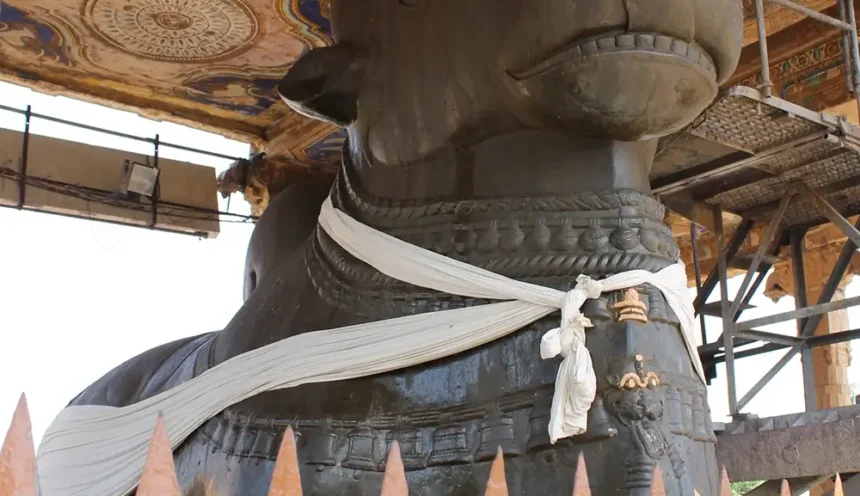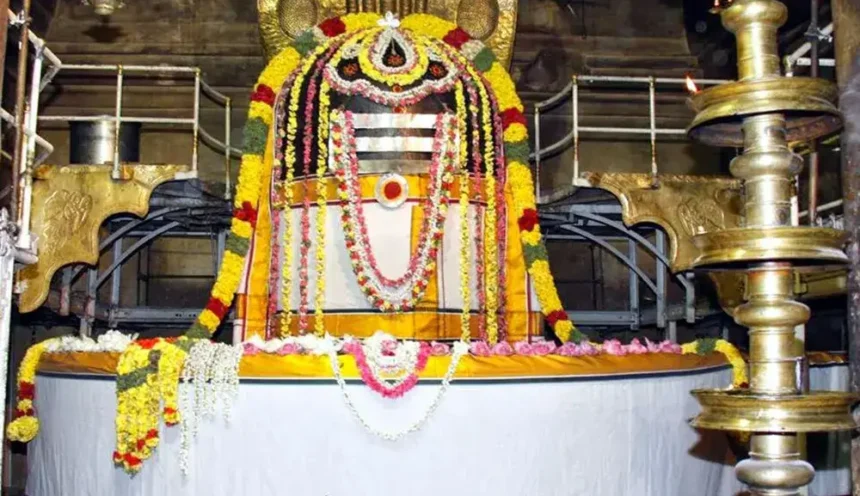I’ve always wanted to go to Thanjavur, and when I walked into the Brihadeeswara Temple, also known as the Thanjavur Big Temple, it felt like I had gone back in time a thousand years. The first thing that stands out about this place is how big it is. The tallest Vimana (Chariot) in the world, which is 216 feet tall, looks like it touches the sky. But it’s made entirely of granite, which isn’t even found nearby. As I walked around, I couldn’t help but wonder how the Cholas did this without modern tools or cranes.
Thanjavur Big Temple Architecture That Will Leave You Speechless
When I visited the Brihadeeswarar Temple, I couldn’t stop thinking that it is 1015 years old. In 2010, it had celebrated 1000 years, and standing there made me feel connected to that moment. Walking inside, I felt the history come alive in every stone and carving.”
The temple grabs your attention as soon as you get close. The Vimana is more than just tall; it’s a symbol of human ambition. The dome(gopuram), which weighs about 80 tons, fits perfectly on top. People from the area told me stories about how it was built with sloping ramps that went on for several kilometers. I could almost see workers pulling huge stones, chanting and working together, with each stone finding its place as if by magic.
One of India’s largest Shiva Lingams, carved from a single stone and weighing about 20 tons, is inside the sanctum. I tried to picture lifting that by hand. It shouldn’t be possible, but here it is after more than a thousand years. Outside, the huge Nandi bull, which is made from one block of granite, stands guard. It is 16 feet long, 13 feet high, and silent.

The walls tell a story all by themselves. The sculptures show 81 different Bharatanatyam dance poses, and the murals, which were painted with natural pigments from flowers and spices, still look bright. It felt like walking through a museum that was alive.
Amazing Architecture and Sculptures that will blow your mind
The temple’s corners all tell stories of ancient creativity. The structure was built with stones that fit together without mortar. These stones have withstood centuries of weather, earthquakes, and human touch. I ran my fingers over some carvings and was amazed that they were still as accurate as they were a thousand years ago.
Some people say that at noon, the Vimana casts almost no shadow. I saw this optical illusion for myself. The shadow was almost invisible because the sun was so high in the sky. This shows how well the Cholas understood geometry and how the sun moves.
Even moving the granite is still a mystery. More than 130,000 tons of granite were used, but there aren’t any quarries close by. Did these stones float down rivers? Rolled on logs? We may never find out. But as you walk here, you realize how big their achievement is.
Thanjai Periya Kovil – Legends and mysteries about the temple
This isn’t just a temple; it’s a treasure trove of stories, whispers, and legends. Local guides talked about the curse of Raja Raja Chola, who is said to have been punished by God for not following a wise advice. Some people talked about secret rituals that might have happened a long time ago and tunnels that went from one palace to another.
I could feel the energy in the air, a mix of love and history. Some stories are mystical, like stones that are lifted by Vedic mantras, hidden codes in inscriptions, and carvings that are meant to show deeper meaning. Some inscriptions have been translated by scholars, but many are still a mystery, which makes me wonder about the secrets that have been lost over time.
Scholars have a hard time figuring out Chola inscriptions
There are Tamil and Sanskrit inscriptions all over the walls of the temple. They keep track of donations, rituals, royal events, and how the temple is run. But some inscriptions suggest that there are hidden codes, numbers that stand for something, or deeper meanings.
I spent a while looking at these inscriptions. Every stroke seemed intentional, as if it were meant to send a message to the traveler who was paying attention. Deep learning, imaging, and digitization are some of the newer technologies that have helped bring back faded text. However, historians still disagree on what they mean. Were these just records? Or did they write down secrets about Chola politics and spiritual wisdom?
The Divine Presence of Various “Deitys”
The Garbhagriha is the temple’s heart, and it is where Lord Shiva rules as a huge Lingam. You can almost feel the presence; the air is heavier, cooler, and full of centuries of devotion.

The goddess Periyanayaki (Parvati) watches from her shrine close by. You can also see Ganesha, Murugan, Nandi, and shrines for saints like Karuvur Devar and Chandeshvara. Sculptures of Nataraja, Bhairava, Ardhanarishvara, and even Vishnu, Durga, Saraswati, and Lakshmi give the impression that they are all connected. You realize that the complex is more than just a Shaivite temple when you walk through it. It welcomes all Hindu worship traditions.
Cultural Importance and Everyday Life
It’s not a museum. These old stones come to life through daily rituals, festivals, and prayers. I was lucky enough to see a prayer ceremony at dawn. The priests moved in a way that seemed timeless, with bells ringing and lamps flickering. People from the area and tourists all joined in, some praying and some just watching in awe.
The temple is not only a place to celebrate architecture; it is also a place to celebrate life, art, and culture. Every carving, inscription, and ritual shows that the people of that time valued knowledge, devotion, and art.
Brihadeeswarar Temple Timings, Location, and Travel Tips for Future Travelers
- Getting There: Thanjavur is well connected by road and train. I came by a local bus from Kumbakonam (40 km) to Thanjavur old bus stand (near to temple). If you travel in train you can reach the temple with in 30 minutes.
- Best Time to Visit: Early mornings are peaceful, but evenings make the temple come alive with lights and chanting.
- Brihadeeswarar Temple Timings: Usually open from morning 6:00 AM to 12:30 PM and afternoon 4:30 PM to 8:30 PM. Palliyarai pooja will happen daily between 8.00 pm to 8.30 pm. Note the main shrine(sannathi) will be starts from 7.00 am to 7.30 am.
- Nearby Attractions: Don’t miss the Darasuram Airavatesvara Temple (another Chola marvel, also a UNESCO site), Punnai Nallur Mariamman Temple, Vasishteswarar Temple Thittai Guru Bhagavan, and the Gangaikonda Cholapuram temple—together they form the “Great Living Chola Temples.”
Myths about the temple
1) Some local claims that the Nandi statue is growing. (No evidence)
2) Leaders who visit the temple will lose their power or die.
3) Shadow of Gopuram will not fall in ground in day time. It is because of architecture of the temple.
My Personal Takeaway from Visiting Brihadeeswarar Temple Thanjavur
- The Brihadeeswarar Temple architecture is not just grand—it is precise, symbolic, and deeply spiritual.
- The temple connects faith, history, and mysticism—through Siddhar Karuvurar’s blessings and the Varahi Amman shrine’s devotion.
- More than a UNESCO site, it is a living temple where daily prayers keep 1000-year-old Thanjavur temple alive.
I came searching for history, but I left with stillness. Maybe that’s what the Thanjavur Brihadeeswarar Temple really offers—space to pause, breathe, and reconnect.
In conclusion, this is a living testament to Chola brilliance
You can’t help but be amazed by human creativity, devotion, and ambition when you walk through the Thanjavur Big Temple. It’s a place where history, art, religion, and science all come together. It’s not just a temple for people who travel, historians, and people looking for spiritual growth; it’s an experience. The size, detail, and energy here remind you that ancient India was able to do things that still amaze people today.
The temple makes a lasting impression, whether you’re amazed by the tall Vimana, tracing the detailed Bharatanatyam carvings, or just sitting in silence. And when you leave, its mysteries, stories, and art stay with you and make you want to come back.
Brihadeeswarar Temple vs Darasuram Airavatesvara Temple
| Feature | Brihadeeswarar Temple (Thanjavur) | Airavatesvara Temple (Darasuram) |
| Built by | Rajaraja Chola I (1010 CE) | Rajaraja Chola II (12th century) |
| Style | Massive scale, towering vimana, murals | Intricate carvings, musical steps, fine details |
| UNESCO Status | Part of “Great Living Chola Temples” | Same UNESCO group |
| Unique Element | Largest Nandi statue, towering vimana | Famous musical steps that produce notes |
| Spiritual Significance | Linked to Siddhar Karuvurar, Varahi Amman | Known for its artistic precision |
FAQs About Brihadeeswarar Temple Darshan, History, and Architecture
1) Who built Brihadeeswarar Temple in Thanjavur?
It was built by Rajaraja Chola I in the year 1003 and 1010 CE (1015 years old).
2) Why is Brihadeeswarar Temple called the Big Temple?
Because of its massive scale, towering vimana, and grand architecture—it’s among the largest temples in India.
3) Is Brihadeeswarar Temple a UNESCO World Heritage site?
Yes, it is part of the Great Living Chola Temples, recognized by UNESCO.
4) What is the role of Siddhar Karuvurar here?
History say Siddhar Karuvurar guided and performed rituals during the temple’s consecration.
5) Is there a Varahi Amman shrine in Brihadeeswarar Temple?
Yes, there is a shrine dedicated to Varahi Amman, worshipped as a protective deity.
6) What is the best time to visit Brihadeeswarar Temple?
Early mornings for peaceful darshan, evenings for vibrant temple atmosphere.
7) What is the cost of entering into the temple?
Free. No cost for entering into the temple.
8) What is famous thing to buy near the temple?
Tanjore dancing doll and paintings.
9) Can we get married in Brihadeeswarar Temple?
No. You can’t get married in Brihadeeswarar temple.


Leave a Reply